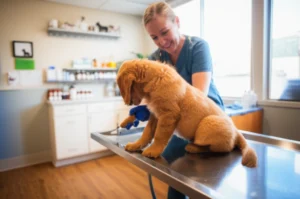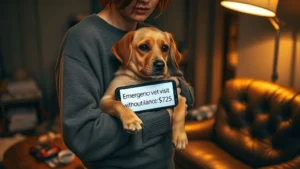Where Panic Starts
So, picture this—you’re sipping your morning coffee, scrolling through random memes, when your dog does that weird thing with his paw. Again. Your chest tightens a little, right? You know it might be nothing… but what if it’s something? And then that awful thought creeps in: What if I don’t have money to go to the vet?
We’ve all heard stories about emergency vet visits that cost as much as a weekend getaway (or, let’s be real, rent). I used to think skipping iced coffee would fix my budget, but when my cat needed stitches, my savings plan suddenly felt like a joke. Have you ever felt that way? The dread is real. But good news—there are ways through it. Let’s dive in, one small, sweaty-palmed step at a time.
How Bad Is It, Really?
Is This an Emergency or a Wait-and-See?
First things first… how scary is the current situation? Sometimes your pet gets into something gross, vomits once, and then looks like nothing happened (pets: the original pranksters). Other times, there’s blood or sudden pain and you just know you can’t wait.
If you’re ever in doubt, call a vet and describe what you see. Many offices will tell you if it’s “come now” or “keep an eye out.” Symptoms like heavy bleeding, struggle to breathe, passing out, or non-stop vomiting? Don’t gamble—get professional advice immediately. You might be surprised how often a call can save an unnecessary trip (and cash) according to research on spending habits.
I nearly dashed to the ER once because my cat was drooling weirdly. And guess what? Turns out he ate a houseplant he wasn’t supposed to, but he was absolutely fine by the time we finished the call. (My wallet was very grateful.)
Sticker Shock: Vet Costs Sneak Up
Just asking yourself, “How much is a emergency vet visit without insurance?” can cause anxiety. The average can range from a mildly upsetting $200 to a stomach-dropping $2,000+ if surgery or overnight care is needed. If you’re bracing for the worst, check out How much is a emergency vet visit without insurance for a quick reality check.
Spoiler: it usually hurts more than you expect. Even basics like X-rays or bloodwork can stack up crazy fast. That’s why so many of us want frugal shortcuts—not just penny pinching but real, practical ways to survive this stuff.
Talk Before You Panic
Don’t Freeze—Communicate!
OK, so… what if you’re already at the clinic with your sick buddy, bill in hand, and your checking account is, um… underwhelming? Here’s something nobody tells you loudly enough: most vets get it. They’ve seen wallet-fear a thousand times, and they’re not rooting for your financial downfall.
Ask about payment plans. Even if it feels awkward. Being honest is your best move. “Can you pay a vet bill later?” isn’t a rude question, it’s a survival question. Many offices work with programs like CareCredit or Scratchpay. These let you break up payment, sometimes interest-free—if you pay on time. The catch? Make those payments (I’ve learned the hard way: penalties stink).
Payment Plan Shortlist
| Option | Why It Helps | Things to Watch |
|---|---|---|
| In-house vet plan | Personal, flexible | May want a deposit |
| CareCredit card | Quick approval, medical focus | Bills stack up fast if you miss due dates |
| Scratchpay | Short-term, small installments | Needs online approval |
One of my friends paid off her dog’s emergency surgery $100 at a time—just by asking. She swears the hardest part was speaking up.
Cheaper Options Exist
Low-Cost Clinics: Not a Pipe Dream
If you flinch at upscale reception areas or dog lattes, try low-cost clinics or animal shelters. Turns out, many community spots offer the basics for (sometimes literally) one-tenth the price. Think vaccines, quick checks, or even basic surgeries.
How do you find them? Humane Society’s Pet Help Finder is a total lifesaver: type your zip, see what’s near, breathe easier. (My neighbor once found a $45 visit for her cat’s eye infection—instead of the $220 bill at a trendy downtown joint. True story.)
For bigger stuff, calling nearby vet colleges is brilliant. Students need the practice, and your pet gets expert care at a bargain.
Charities and Vet Assistance—Real, Not Just Rumors
We hear a lot about charities that help pay vet bills, but can they really help you, right now? Actually… yes, sometimes. Especially for things like Emergency vet bill assistance. A bunch of national, state, and even breed-specific groups exist just for this. They may not cover everything, but every little bit chips away at those scary bills.
Check out Charities that help pay vet bills to start scrolling for help—and don’t be shy. You wouldn’t believe how many folks have applied and gotten at least partial help, even a couple hundred dollars when it counted.
If your pet’s emergency is now-now-now, you can also look for Emergency vet bill assistance programs or simply call 211 for local resources (food pantries that help pets, for example, so you can reallocate grocery cash to urgent care according to Humane World.)
Charity Quick Picks
- RedRover Relief – crisis grants (up to $200+)
- The Pet Fund – for chronic but non-emergency issues
- Brown Dog Foundation – major surgeries for pets with a good prognosis
- Breed-specific groups – like CorgiAid or specific cat/ferret funds
- State/area-based resources – search by your region
What do you have to do? Usually fill out a form, maybe show income or a vet’s estimate. Takes a little time (yes, the paperwork is annoying), but sometimes it’s the make-or-break factor.
Total confession: one of my friends ran a GoFundMe for her parrot’s broken wing. Thought it’d be embarrassing… but her Facebook group covered the whole thing by the next day. Sometimes people like helping, if you just ask.
The Power of Frugal Prevention
How to Build Your Pet Buffer
So, what if you never want to be here again—where you’re refreshing your account balance and sweating over vet bills? Here comes the pet emergency fund. It starts, not with grand plans, but with tiny, silly habits.
I have a jar next to the treat bowl. Every few times I skip Starbucks, I pop that $5 in. Sounds dorky, but by the time my pup needed antibiotics, I already had $200 in “dog coins.” Practical? Yes. Fancy? Not one bit.
If you like structure, add a line to your budget—just “pet fund, $10/week.” It’s less than movie snacks and way more satisfying in a crisis.
Does Pet Insurance Make Sense?
Okay, I used to roll my eyes at the idea of pet insurance—I was sure it was a scam. But after a $750 “surprise” when my elderly cat collapsed suddenly, I’m rethinking.
Pet insurance is basically car insurance for your furry co-pilot. Pay a monthly fee (maybe $25–$50), they’ll reimburse you a chunk (like 70–90%) of big surprise bills, after you hit a deductible. Is it always worth it? Well, that depends. If you’d borrow money for emergencies or worry non-stop, it might be. (A lot of frugal folks are fans of CarePlus from Chewy, if you’re investigating plans.)
Not sure if you can find one that’s right for you? Ask your vet what they recommend, or check forums for real opinions—not just the ads.
Pet Savings Quick Wins
- DIY grooming (YouTube taught me to trim nails…my dog disagrees, but my wallet loves me for it!)
- Batch-buying food—splitting bulk purchases with a friend can save 30%+
- Home-cooked treats—safer and way cheaper than $8 bones
- Partner with neighbors for dog-walking or pet-sitting swaps (trade, not pay!)
- Keep up on basics: shots, flea/tick meds, portion control (chubby pets have more problems)
If you want even more smart ideas for stretching dollars without cutting corners, these practical money saving strategies are lifesavers (and sometimes laugh-out-loud relatable).
Hey, You’ve Got This
So here’s the honest truth nobody says aloud: it’s scary to wonder, What if I don’t have money to go to the vet? But it’s also more common than you’d think.
Next time your pet’s in trouble and your budget’s stretched so tightly you could strum it like a banjo, remember—you’re not alone, and you have options.
First: Don’t panic; call a local clinic and ask about plans, or search for emergency vet bill assistance for immediate options.
Second: Try low-cost clinics, teaching hospitals, or charities that help pay vet bills—you’d be surprised how many people quietly do the same.
Third: Add a small pet fund to your routine. Even a few dollars a week piles up. And if you ever skip a latte, it’s not just self-control—it’s a deposit in the “don’t freak out” fund.
Making smart, frugal moves for your fur family doesn’t mean you love them less. It just means you’re resourceful—exactly the kind of pet parent every animal deserves. Your pet’s tail will keep wagging, and your money won’t leave you in a cold sweat at the vet.
You’ve got ideas, a little inspiration, and (hopefully) more peace of mind. Go curl up with your four-legged friend—you’ve earned it. And hey, share your own “make it work” stories below. No judgment, just solidarity.













